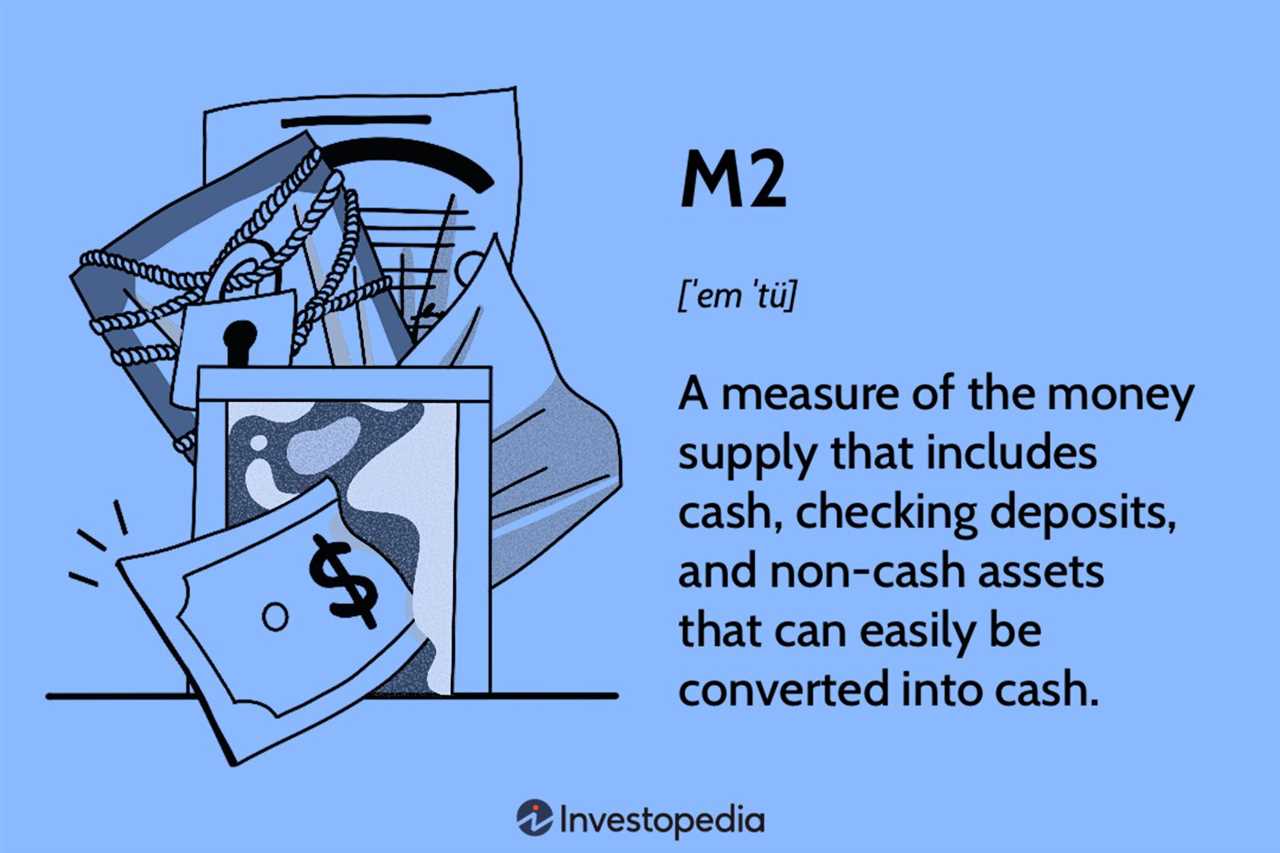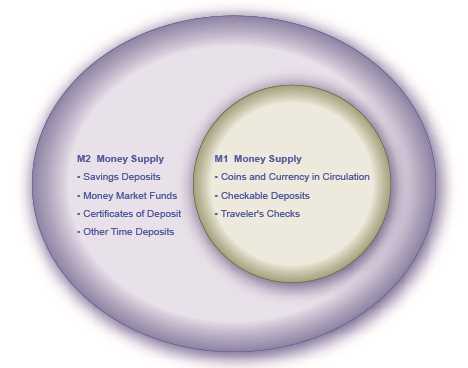M2 Definition and Meaning in the Money Supply
What is M2?
M2 is a broader measure of the money supply compared to M1, which only includes physical currency and coins, demand deposits, and other highly liquid assets. M2, on the other hand, includes M1 and adds other types of deposits that are less liquid but still readily available for spending or investment.
Significance of M2 in the Economy

M2 is an important indicator of the overall liquidity in the economy and reflects the availability of funds for spending and investment. Changes in M2 can have significant implications for monetary policy, economic activity, and inflation.
When M2 increases, it indicates that there is more money available for spending and investment, which can stimulate economic activity. On the other hand, if M2 decreases, it may signal a decrease in available funds, which can have a dampening effect on economic growth.
Impact on Monetary Policy
M2 plays a crucial role in the formulation and implementation of monetary policy. Central banks closely monitor changes in M2 to assess the overall liquidity in the economy and make informed decisions regarding interest rates and other policy tools.
If M2 is growing rapidly, it may indicate an increase in inflationary pressures, prompting central banks to raise interest rates to curb inflation. Conversely, if M2 is growing slowly or declining, central banks may lower interest rates to stimulate economic growth.
Measuring Economic Activity and Inflation

M2 is also used as a measure of economic activity and inflation. By tracking changes in M2 over time, economists can gain insights into the pace of economic growth and inflationary pressures within an economy.
When M2 is growing rapidly, it suggests that there is a higher demand for money, which can be indicative of increased economic activity. Conversely, if M2 is growing slowly or declining, it may signal a decrease in economic activity.
Implications for Investors and Financial Markets
Changes in M2 can have significant implications for investors and financial markets. An increase in M2 can lead to higher liquidity, potentially driving up asset prices and creating investment opportunities. Conversely, a decrease in M2 can result in lower liquidity, which may lead to a decrease in asset prices and limited investment opportunities.
One of the main reasons M2 is important is because it provides insights into the liquidity of an economy. Liquidity refers to the ease with which assets can be converted into cash. A higher M2 indicates a larger pool of funds available for spending and investment, which can stimulate economic activity.
Furthermore, M2 is used as an indicator of economic growth and inflation. An increase in M2 can suggest that the economy is expanding, as more money is available for consumption and investment. On the other hand, a rapid increase in M2 can also be a sign of potential inflationary pressures, as too much money chasing too few goods can lead to rising prices.
Investors and financial markets also pay attention to changes in M2. Fluctuations in M2 can impact interest rates, which in turn affect the cost of borrowing and investment returns. By monitoring M2, investors can gain insights into potential changes in the economic landscape and adjust their investment strategies accordingly.
| Key Points: |
|---|
| – M2 is a measure of the money supply that includes cash, demand deposits, savings deposits, time deposits, and money market mutual funds. |
| – M2 provides insights into the liquidity of an economy and is used by central banks to manage monetary policy. |
| – Changes in M2 can indicate economic growth, inflationary pressures, and impact interest rates. |
| – Investors and financial markets monitor M2 to gain insights into potential changes in the economic landscape. |
The Components of M2 and How They Impact Monetary Policy
Monetary policy plays a crucial role in managing the economy, and one of the key indicators used by central banks to assess the state of the economy is the money supply. M2 is a measure of the money supply that includes not only physical currency but also various types of deposits and other liquid assets.
M2 consists of several components, each with its own impact on monetary policy:
1. Currency in circulation: This component includes all physical currency in the hands of the public, such as banknotes and coins. Changes in the amount of currency in circulation can affect the overall money supply and, consequently, the effectiveness of monetary policy.
3. Savings deposits: Savings deposits are accounts that individuals and businesses use to save money over a longer period. These deposits typically offer higher interest rates than demand deposits but have restrictions on withdrawal frequency. Changes in savings deposits can indicate shifts in consumer saving behavior and affect the overall money supply.
6. Other liquid assets: This component includes various other liquid assets, such as repurchase agreements, Eurodollars, and Treasury bills. These assets are highly liquid and can be easily converted into cash. Changes in other liquid assets can reflect changes in financial market conditions and impact the overall money supply.
The components of M2 have different levels of liquidity and availability for spending, which can influence the effectiveness of monetary policy. Central banks closely monitor these components to assess the state of the economy and make decisions regarding interest rates, lending practices, and other policy tools.
The Role of M2 in Measuring Economic Activity and Inflation
M2, as a measure of the money supply, plays a crucial role in measuring economic activity and inflation. It provides valuable insights into the overall health and stability of an economy.
Measuring Economic Activity
M2 includes various components such as currency, demand deposits, and time deposits. These components represent the money available for spending and investment in an economy. By tracking the changes in M2 over time, economists can gauge the level of economic activity.
When M2 increases, it indicates that there is more money circulating in the economy, which can lead to increased spending and investment. This can stimulate economic growth and indicate a healthy economy. On the other hand, a decrease in M2 may suggest a slowdown in economic activity.
Economists and policymakers closely monitor M2 as it provides insights into the overall state of the economy. By analyzing the trends in M2, they can make informed decisions regarding monetary policy, fiscal policy, and other economic interventions.
Measuring Inflation
M2 is also a crucial indicator for measuring inflation. Inflation refers to the general increase in prices of goods and services over time. By tracking changes in M2, economists can assess the potential inflationary pressures in an economy.
When M2 increases at a faster rate than the growth of the economy, it can indicate an excess supply of money. This excess supply can lead to increased demand for goods and services, which can drive up prices and result in inflation. Conversely, a slower growth rate in M2 may suggest lower inflationary pressures.
Central banks and policymakers use M2 as a tool to monitor and control inflation. They can adjust monetary policy measures, such as interest rates and reserve requirements, to manage the growth of M2 and stabilize inflation.
The Implications of Changes in M2 for Investors and Financial Markets
One of the key implications of changes in M2 is their impact on interest rates. When M2 increases, it indicates that there is more money available in the economy, which can lead to lower interest rates. Lower interest rates make borrowing cheaper and can stimulate economic activity. This is positive for investors as it can lead to increased business investment and consumer spending, which can drive up stock prices and boost corporate profits.
Conversely, when M2 decreases, it suggests that there is less money available in the economy, which can result in higher interest rates. Higher interest rates make borrowing more expensive and can dampen economic activity. This can have a negative impact on investors as it can lead to decreased business investment and consumer spending, which can lower stock prices and reduce corporate profits.
Changes in M2 can also provide insights into inflationary pressures in the economy. If M2 is growing rapidly, it may indicate that there is excess liquidity in the system, which can fuel inflation. Inflation erodes the purchasing power of money and can have a negative impact on investment returns. Investors need to be aware of inflationary pressures and adjust their investment strategies accordingly to protect against the erosion of their wealth.
Overall, changes in M2 can have far-reaching implications for investors and financial markets. It is important for investors to closely monitor changes in M2 and understand their potential impact on interest rates, inflation, and asset class performance. By staying informed and adapting their investment strategies accordingly, investors can position themselves to take advantage of opportunities and mitigate risks in a dynamic economic environment.

Emily Bibb simplifies finance through bestselling books and articles, bridging complex concepts for everyday understanding. Engaging audiences via social media, she shares insights for financial success. Active in seminars and philanthropy, Bibb aims to create a more financially informed society, driven by her passion for empowering others.
